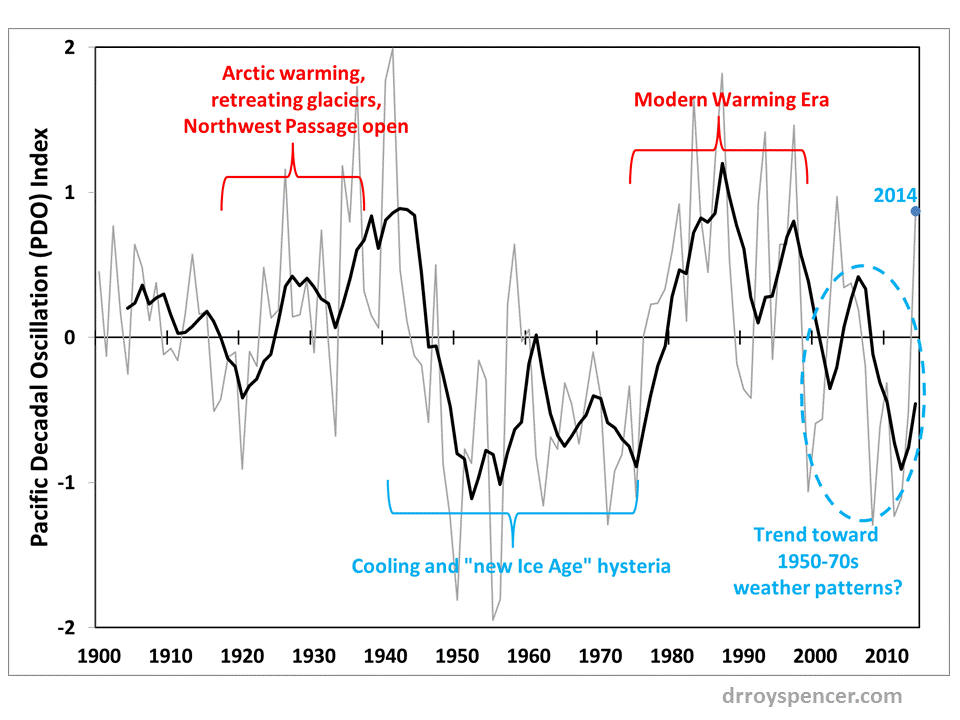With the hopes of an El Nino fading (now reduced to a 58% probability), and what could be another early start to an unusually cold and snowy winter, it is useful to take a step back and examine why some of us have been harping for years on what really controls North American climate variations on the timescale of your lifetime: natural climate cycles.
The most prominent of these are the Pacific Decadal Oscillation (PDO) and the Atlantic Multidecadal Oscillation (AMO).
Not only do these cycles profoundly influence North American climate, there is considerable evidence that they are partly responsible for that popular hobgoblin, “global warming”.
As the following graphic shows, the PDO — which was originally discovered as the main control over fisheries productivity off the west coast of North America — is also related to periods when global temperatures were rising or falling, which tend to occur over ~30 year periods:

Yearly Pacific Decadal Oscillation values, and the corresponding periods of popular climate change awareness (light gray is yearly values, dark line is 4-yr trailing averages).
We aren’t sure how this happens, but small natural variations in global average cloud cover changing how much sunlight is let into the climate system are a strong possibility.
The issue is important because, to the extent that natural climate cycles are partly responsible for recent global warming, the less reason there is to be concerned about energy policies which reduce the use of fossil fuels, currently necessary for human prosperity. With today’s news that President Obama will continue to pursue executive action on climate change, while not requiring equal commitments from the largest greenhouse gas emitter China, it is important that people understand that most of what we experience in terms of weather and climate change is largely out of our control.
The trouble with including natural climate cycles in the national discussion of global warming is both political and scientific: (1) it doesn’t fit the global warming narrative driven by policy goals, and (2) we don’t understand what causes natural climate cycles, and so they cannot be included in computer climate models.
Government research funding for at least 25 years has hinged on the assumption of human causation, and as I have always said, if you fund scientists to find a connection, they will indeed find it. That’s why the resulting research that is published also is dominated by explanations involving human causation.
Nevertheless, it is fairly easy to show that natural cycles are indeed involved in not only regional changes, but “global warming” as well.
For example, the accompanying spreadsheet shows that over the most recent warming period (since the late 1970s), the PDO, AMO, and El Nino/La Nina activity can statistically account for most of the recent warming of global average sea surface temperatures.
But statistics aren’t enough. Since we understand that carbon dioxide is a greenhouse gas, and should cause some warming, but we don’t understand natural climate cycles, scientists only look where the streetlight of government funding illuminates the problem: CO2.
What complicates policymaking even further is that what motivates public perceptions and thus decision makers the most are weather events. Hurricane Sandy. A snowy winter. We end up blaming these on the only thing we thing we think we understand — increasing CO2 should cause some change, so it must be responsible for all of the change we see.
Those natural cycles — well documented in the scientific literature for at least their regional effects — are forgotten. Except by some of us who have been working in the climate field for at least a few decades. Ask Weatherbell’s Joe Bastardi, who has been talking about these natural cycles for years — and using them to make good long-range forecasts.
The recent admission that natural changes are responsible for the California drought was not news to some of us. What is news is that some pretty big research names that would be assumed to be part of the global warming bureaucracy are the ones now saying it.
So, as the unseasonal cold settles in over the U.S. this week, don’t be fooled by those who claim “global warming causes cooling”. What we are seeing is natural variability, likely dominated by the oceans. The “new weather norm” might well be different from what anyone less than 30 years old has been used to.
To the extent that human-caused warming is occurring, I am increasingly convinced it is a largely benign — and possibly beneficial — needle lost in the haystack of Mother Nature’s natural climate gyrations.

 Home/Blog
Home/Blog



